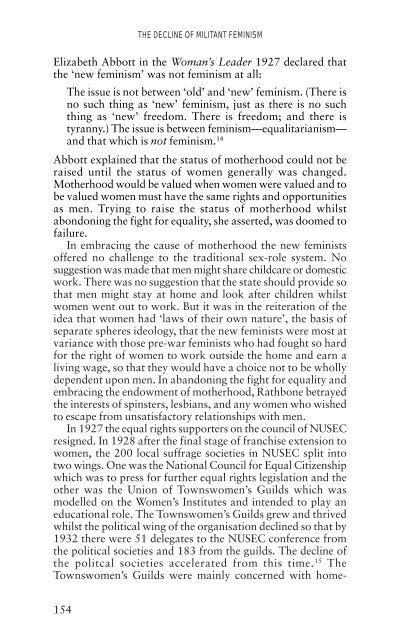The Spinster and Her Enemies - Feminish
The Spinster and Her Enemies - Feminish
The Spinster and Her Enemies - Feminish
You also want an ePaper? Increase the reach of your titles
YUMPU automatically turns print PDFs into web optimized ePapers that Google loves.
THE DECLINE OF MILITANT FEMINISM<br />
Elizabeth Abbott in the Woman’s Leader 1927 declared that<br />
the ‘new feminism’ was not feminism at all:<br />
<strong>The</strong> issue is not between ‘old’ <strong>and</strong> ‘new’ feminism. (<strong>The</strong>re is<br />
no such thing as ‘new’ feminism, just as there is no such<br />
thing as ‘new’ freedom. <strong>The</strong>re is freedom; <strong>and</strong> there is<br />
tyranny.) <strong>The</strong> issue is between feminism—equalitarianism—<br />
<strong>and</strong> that which is not feminism. 14<br />
Abbott explained that the status of motherhood could not be<br />
raised until the status of women generally was changed.<br />
Motherhood would be valued when women were valued <strong>and</strong> to<br />
be valued women must have the same rights <strong>and</strong> opportunities<br />
as men. Trying to raise the status of motherhood whilst<br />
abondoning the fight for equality, she asserted, was doomed to<br />
failure.<br />
In embracing the cause of motherhood the new feminists<br />
offered no challenge to the traditional sex-role system. No<br />
suggestion was made that men might share childcare or domestic<br />
work. <strong>The</strong>re was no suggestion that the state should provide so<br />
that men might stay at home <strong>and</strong> look after children whilst<br />
women went out to work. But it was in the reiteration of the<br />
idea that women had ‘laws of their own nature’, the basis of<br />
separate spheres ideology, that the new feminists were most at<br />
variance with those pre-war feminists who had fought so hard<br />
for the right of women to work outside the home <strong>and</strong> earn a<br />
living wage, so that they would have a choice not to be wholly<br />
dependent upon men. In ab<strong>and</strong>oning the fight for equality <strong>and</strong><br />
embracing the endowment of motherhood, Rathbone betrayed<br />
the interests of spinsters, lesbians, <strong>and</strong> any women who wished<br />
to escape from unsatisfactory relationships with men.<br />
In 1927 the equal rights supporters on the council of NUSEC<br />
resigned. In 1928 after the final stage of franchise extension to<br />
women, the 200 local suffrage societies in NUSEC split into<br />
two wings. One was the National Council for Equal Citizenship<br />
which was to press for further equal rights legislation <strong>and</strong> the<br />
other was the Union of Townswomen’s Guilds which was<br />
modelled on the Women’s Institutes <strong>and</strong> intended to play an<br />
educational role. <strong>The</strong> Townswomen’s Guilds grew <strong>and</strong> thrived<br />
whilst the political wing of the organisation declined so that by<br />
1932 there were 51 delegates to the NUSEC conference from<br />
the political societies <strong>and</strong> 183 from the guilds. <strong>The</strong> decline of<br />
the politcal societies accelerated from this time. 15 <strong>The</strong><br />
Townswomen’s Guilds were mainly concerned with home-<br />
154

















